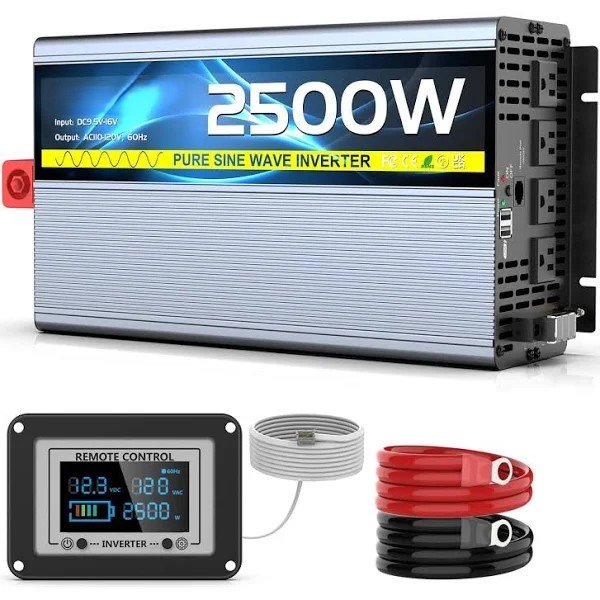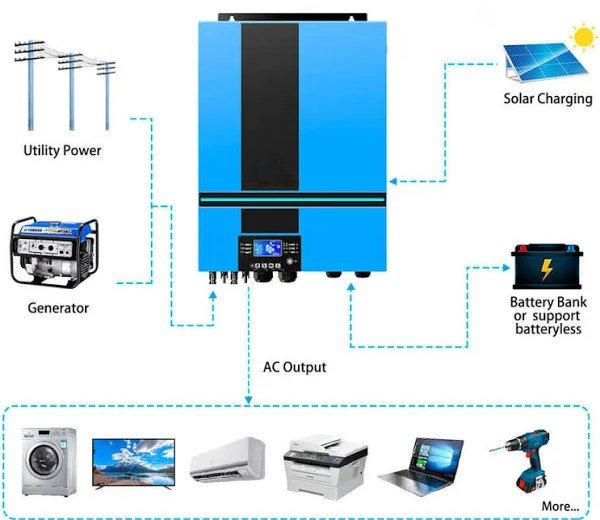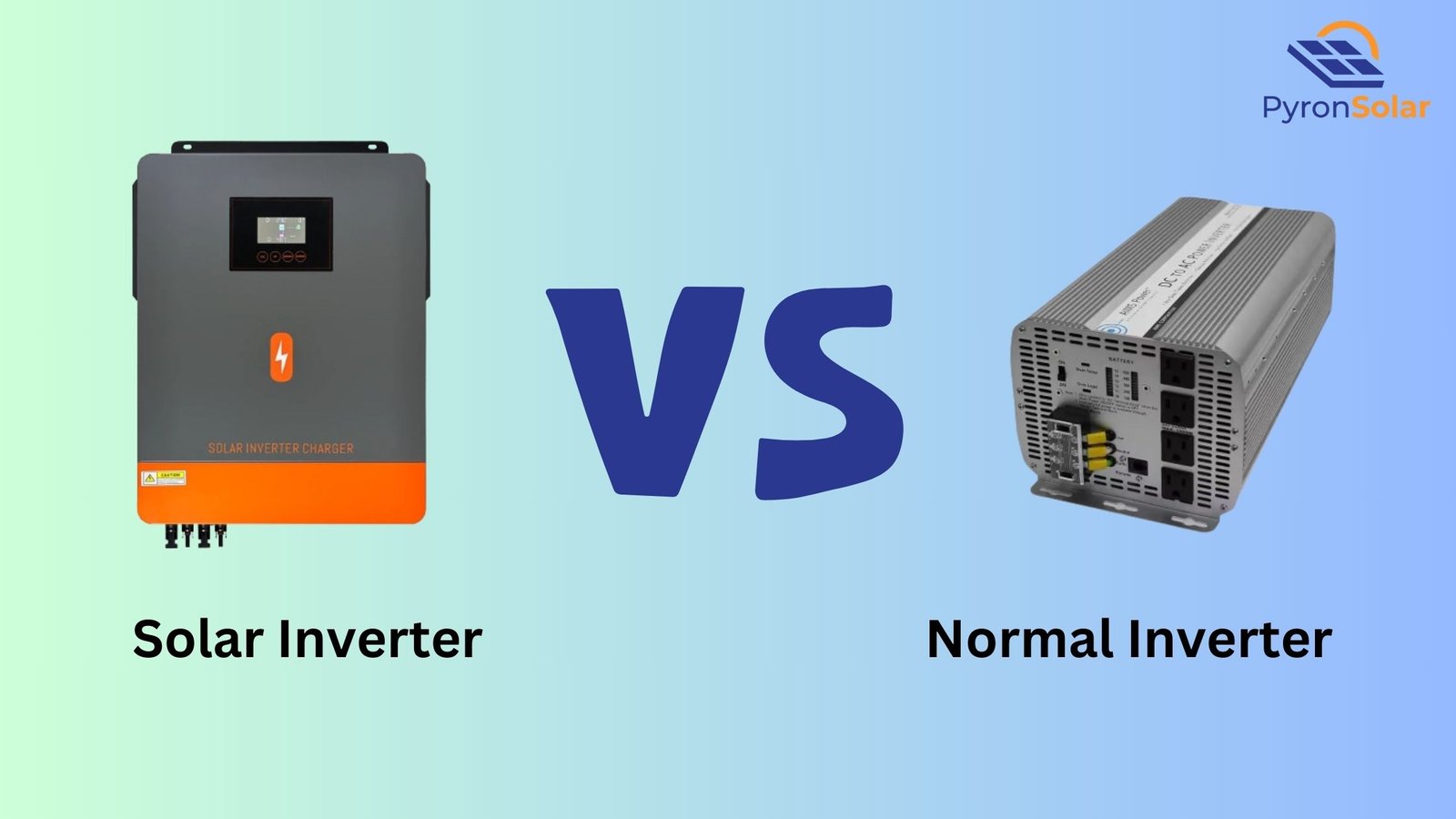An Inverter is a device used to convert DC (Direct Current) into AC (Alternating Current). In simple words, an inverter helps convert DC into AC, allowing its usage in day-to-day household appliances (that require AC power).
While both, Solar and Normal inverters have advantages and disadvantages suitable for different purposes. Although, considering lifespan, solar inverters last longer for 10 to 20 years compared to the normal inverters that last up to 10 years. However, the initial cost and other factors must be taken into account.
The buyers need to know the difference between Solar Inverter and Normal Inverter. A solar inverter is the most essential component of the solar power system, which converts the DC electricity obtained from panels into AC electricity which could be usable for homes or businesses. Whereas, Normal Inverter uses the existing power stored in batteries during power outages.
Are you considering opting for an inverter? Then, you have landed on the right page, as we will be discussing how a normal inverter and solar inverter work. Also, we will explain the differences between solar inverters and normal inverters. Most importantly, you will be well-prepared with an understanding of Inverter Warranties and Lifespan.
How Does a Normal Inverter Work?
The fundamental working principle of a traditional inverter refers to converting DC (Direct Current) into AC (Alternating Current) in a specified range of frequency and voltage.

Here is a detailed breakdown of the most important phases of its working and operation:
1. Conversion Process
The inverter plays an important role in controlling the voltage and frequency of the power supply. And, it easily changes the rotation speed of motors operating in home appliances and industrial machinery.
Further, the converter circuit converts the Alternating Current (AC) from the power source into Direct Current (DC). Again, the inverter circuit changes the converted DC into AC, resulting in AC with a different voltage and frequency.
2. Voltage and Frequency Control
The inverter circuit generates AC (Alternating Current) with an adjustable voltage and frequency. Hence, this is generally made possible by switching power transistors, such as – IGBT (Insulated Gate Bipolar Transistor). Also, maintaining change in the ON/OFF cycles, creating pulse-like waves with varied widths.
3. Wave Format Generation
An Inverter switch results in a square voltage waveform because of its simple on-and-off nature. It is opposed to the sinusoidal shape waveform of an AC power supply. Thus, other electronics including the filters could be used effectively to create a voltage that appears as clean. Hence, the same sine wave is repeated and can be sent into the power grid.
4. Applications and Types
Inverters are often used for various applications, including power supply to home appliances, PV systems, isolated houses, boats, camper vans, etc.
Different types of inverters include — pure sine wave inverters, modified square wave inverters, and square wave inverters. Also, it can be used for many loads and applications.
How Does a Solar Inverter Work?
The fundamental working principle of a solar inverter consists of lightning-quick direction switching of a DC input to turn it into AC electricity. Therefore, this process is carried out by using power electronics that control the flow of electrical power. As a result, it includes using IGBT (Insulated Gate Bipolar Transistors) to improve the DC-to-AC conversion.

Here is a detailed breakdown of the most important phases of its working and operation:
1. DC-to-AC Conversion
The solar inverter works to perform successful conversion of the DC-to-AC. It quickly switches the DC input direction back and forth very swiftly and as a result, the DC input becomes an AC output. However, other electronics including the filters can produce voltage in a sine wave pattern.
2. Grid Connection
Most solar inverters are manufactured to be connected to a utility grid. And, they are equipped with special circuits designed to match the voltage, frequency, and grid phase accurately. In cases where the grid is not detected, grid-tie inverters will not supply power to avoid ‘islanding’, which is capable of causing many safety issues.
3. Monitoring and Communication
Another best feature of solar inverters is monitoring the system and serving as a portal for communication with computer networks. As a result, this special functionality of the solar inverter becomes important for the efficient operation and maintenance of the entire solar system.
4. Advanced Features
Few solar inverters come with advanced features such as the MPPT (Maximum PowerPoint Tracking) to help maximize the power output from the PV array and anti-islanding protection, making sure to operate safely within a photovoltaic system.
Major Differences Between Solar Inverters and Normal Inverters
Solar inverters and normal inverters have few differences in their functional capabilities. Wherein, the Solar inverters are primarily built to convert the DC (Direct Current) into AC (Alternating Current) obtained through the use of solar panels. Also, advanced inverters are required for solar-plus-battery storage systems to maintain operation without any grid support during outages.
Whereas, on the other hand, normal inverters are used for general purposes only. Hence, this can be used to convert the DC obtained from batteries or fuel cells to AC electricity. Mostly, their purpose is used in the UPS (Uninterruptible Power Supplies) during power outages.
Different Functions of a Normal Inverter
Normal Inverter has several functions, of which it includes:
- Converter: They help to convert the Direct Current (obtained from sources like — batteries or fuel cells) to Alternating Current.
- Charger: In certain cases, normal inverters are provided with built-in battery chargers that help to charge the batteries when connected to an AC power source.
- Inverter: Generally, these inverters convert DC electricity to AC electricity to power up different appliances and equipment.
Additional Components in Solar Inverters
Compared to the normal or traditional inverters, the Solar inverters tend to have few additional components:
- Solar Charge Controller: This component effectively charges a battery simply from solar (without using an inverter). Also, it controls the voltage and current going from solar panels to batteries.
- Blocker: Solar inverters might also include a blocker that helps to prevent electricity flow from solar panels to the grid during power outages. Thus, it ensures the safety of maintenance crew members working on the grid.
Solar Inverter vs Normal Inverter: Cost Difference
The cost of solar inverter and normal inverter varies depending on many factors, including efficiency levels and overall system size. Generally, the more the inverter costs, the greater the efficiency it possesses. In some cases, even a lower-cost solar inverter is capable of achieving a 93% conversion rate.
Let us see in a simple table format, which will make it easier for you to understand the cost difference between normal inverters and solar inverters:
| Factors | Solar Inverters | Normal Inverters |
| Cost Range |
|
The cost of a Normal Inverter can vary based on the technology used and its capacity. |
| Cost Per Watt | $0.18 to $0.27 | Keeps varying |
| Long-term Savings | Saves you money in the long run as it reduces your electricity bills. | You won’t be able to make any savings as it does not generate power. |
| Maintenance Cost | Typically, the cost is higher due to the more complex and advanced technology used. | It completely depends on the model and its usage. |
| Replacement Cost | Usually higher! As it includes costly components in the making. | Depends on the model and usage. |
NOTE: Though the initial costs of a solar inverter are higher than a normal inverter, it is capable of saving you money in the long run.
Understanding Inverter Warranties and Lifespan
There are several factors to be considered when it comes to understanding the lifespan and warranties of solar inverters and traditional inverters.
Lifespan of Inverters
- Solar Inverters:
On average, a solar inverter’s lifespan ranges from 10 to 25 years. Generally, a residential string inverter would last about 10 to 15 years and might need replacement at some point in the panel’s life. Whereas, the DC optimizers are integrated with string inverters that last for 20 to 25 years. However, the lifespan of solar inverters can vary depending on factors such as — the type, quality, and operating conditions.
- Traditional Inverters:
The average lifespan of a traditional inverter ranges from 10 to 15 years. Although they require a sure replacement during their life. But still, if taken care of proper maintenance, its lifespan can range up to 20 years or more. However, the lifespan of traditional inverters can vary depending on factors such as — temperature fluctuations, exposure to elements, and perfect maintenance practices.
Warranty of Inverters
- Solar Inverters:
Typically, the warranty period of a solar inverter ranges from 5 to 15 years, while some companies try to push the timeline from 10 to 20 years too. However, it depends on the inverter type and its manufacturer. Also, MLPEs (Module-level power electronics) like microinverters or power optimizers have a typical warranty period of 25 years. However, companies which don’t offer 20 years of warranty would have an option to extend the period for an additional cost. There is also much more to know about solar inverter warranties.
- Traditional Inverters:
The warranty period of a traditional inverter ranges from 5 to 10 years. On the other hand, microinverters and DC optimizers tend to have extended warranty periods that range from 20 to 25 years. However, the warranty period of a traditional inverter can vary depending on factors like – the inverter type, brand and their specific model.
Ray is an avid reader and writer with over 25 years of experience serving various domestic and multinational private and public energy companies in the USA.

